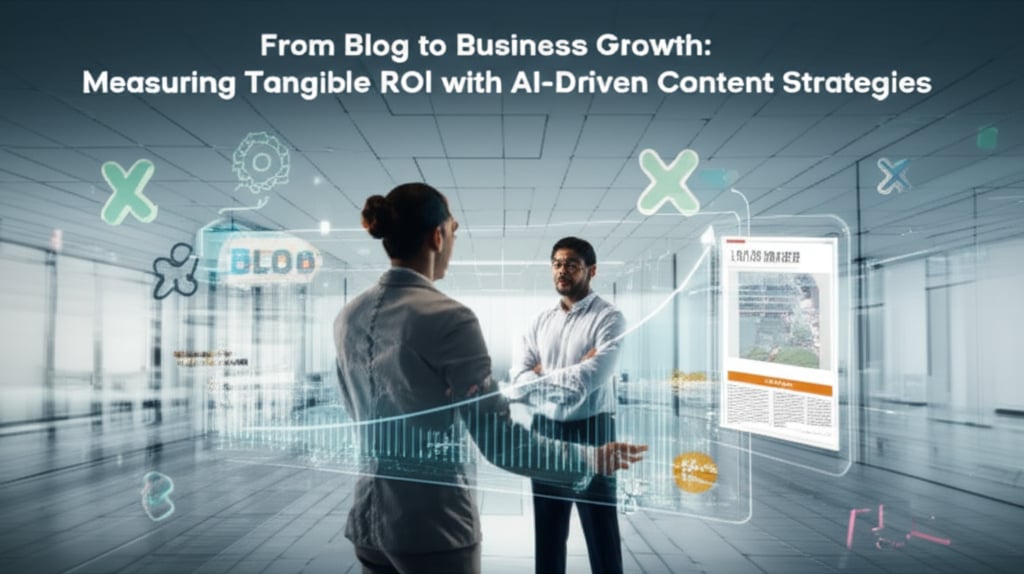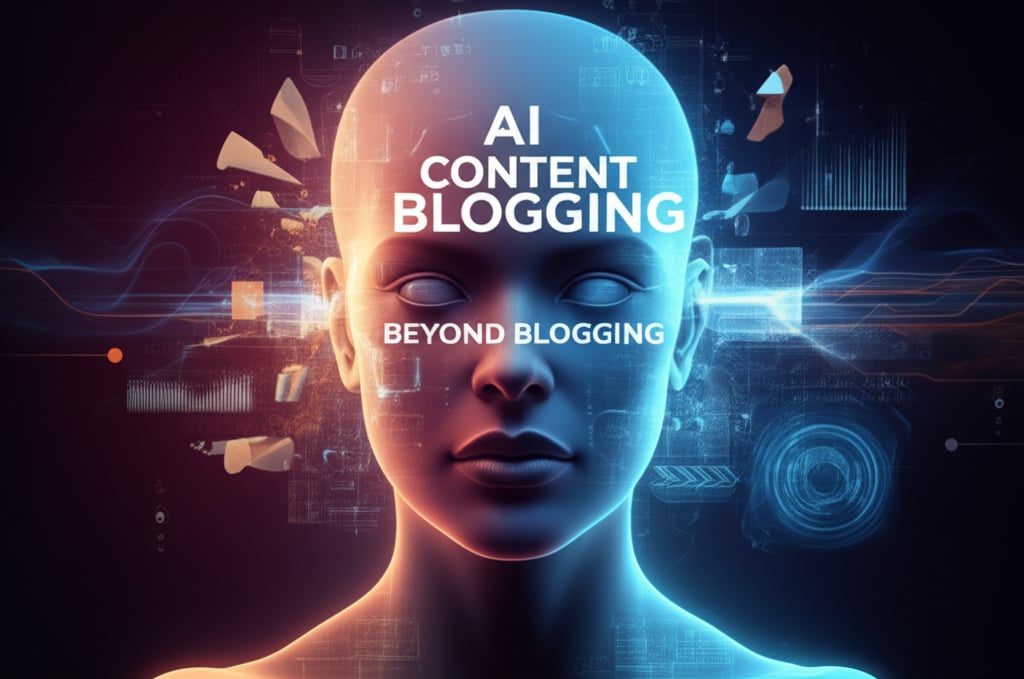From Blog to Business Growth: Measuring Tangible ROI with AI-Driven Content Strategies

Transforming Content into Profit: Unveiling Quantifiable ROI from AI-Powered Strategies
Achieve exceptional business expansion by expertly gauging the concrete return on investment derived from content initiatives powered by Artificial Intelligence. This comprehensive resource is designed for visionary entrepreneurs, agile marketing departments, and specialized SEO firms, enabling them to convert content endeavors into verifiable financial gains and a commanding market presence.
In Brief: AI Content and Its Business Impact
- AI-powered content approaches drive substantial, quantifiable expansion for businesses.
- Standard ROI metrics fall short for AI applications; a novel evaluative structure is indispensable.
- Implement foundational metrics, distinguish between direct and indirect benefits, and compute AI-specific ROI to secure market leadership.
Crucial Point: Rigorous and forward-thinking evaluation of AI-driven content ROI is now a non-negotiable requirement for entities aiming for industry leadership.
The Dawn of AI-Powered Content: A Catalyst for Enterprise Expansion

The contemporary digital realm demands not merely existence, but assertive strategic advancement. For pioneering entrepreneurs, agile marketing units, and specialist SEO firms, the mandate is unequivocal: every capital outlay must generate discernable, concrete returns. Conventional content methodologies, frequently bogged down by manual labor and uncertain results, can no longer provide the necessary momentum for market preeminence. The age of content propelled by Artificial Intelligence is upon us, offering not just improved operational efficacy, but a direct route to quantifiable commercial progress. The paramount hurdle, however, lies in precisely quantifying this revolutionary return on investment (ROI). This guide offers an exhaustive blueprint for evolving from generalized online writing to a potent content generating powerhouse, diligently monitoring the monetary repercussions of your AI-fueled ventures.
The paradigm shift in digital marketing is evident: content has transcended its purely informative role to become a pivotal engine of strategic development. Organizations historically contended with the immense temporal and financial outlays linked to manual content generation, struggling to consistently secure premier search engine positions and establish irrefutable credibility. Presently, AI transmutes this formidable obstacle into an extraordinary advantage. AI-centric content approaches extend beyond rudimentary automation, functioning as a robust mechanism that transmutes specialized knowledge into leading articles, systematically cementing market dominance. This deliberate application liberates vital assets, permitting teams to concentrate on primary business functions while AI persistently targets lucrative keywords and draws in traffic with remarkable accuracy. The objective is unambiguous: harness AI not solely for content output, but to construct a sophisticated content apparatus that guarantees demonstrable business augmentation.
Crucial Point: AI transforms content creation from a laborious task into a strategic asset, directly impacting market authority and business growth.
Beyond Superficial Indicators: Why Conventional ROI Falls Short for AI-Generated Content
Businesses routinely grapple with the difficulty of precisely evaluating the genuine worth of their AI expenditures. While almost 70% of executives anticipate considerable investment in AI ventures—with projections indicating a massive surge in infrastructure spending to over $350 billion in 2025—a substantial proportion—reportedly up to 95% in certain analyses—find it challenging to prove a significant return. Conventional ROI computations, which simply divide net earnings by total outlay, are intrinsically ill-equipped to capture the diverse, frequently indirect advantages of content created with AI. These frameworks are designed for straightforward, linear investments, not for the intricate, cumulative value stemming from intelligent automation. Analysis from a prominent consulting firm indicates that companies often misapprehend AI ROI because its benefits are indirect, hard to pinpoint, or emerge outside standard reporting cycles, frequently in unforeseen domains. This inherent complexity necessitates a more refined methodology, one that extends beyond mere expense reduction to encompass the strategic benefits and enduring value generation intrinsic to AI-fueled content endeavors. The intense competitive environment compels a pivot from simply monitoring actions to rigorously quantifying impact, guaranteeing that each AI implementation directly contributes to overarching strategic objectives.
Insight: A significant majority of AI projects reportedly struggle to deliver substantial ROI, underscoring a critical deficiency in measurement approaches rather than a limitation of AI's capabilities.
Crucial Point: Standard ROI paradigms are insufficient for AI-driven content, which yields intricate, often circuitous, and protracted value, demanding an advanced evaluation structure.
Laying the Groundwork: Establishing Benchmarks and Pinpointing Value Streams
To accurately gauge the ROI of AI-powered content, one must first meticulously establish a baseline and thoroughly comprehend the various facets of value generation. Prior to deploying any AI system, it is crucial to record the existing state across all relevant performance domains. This foundational measure offers an irrefutable reference point, vital for showcasing concrete advancement and validating strategic expenditures. Research from a renowned business publication affirms that enterprises which define clear initial benchmarks are significantly more likely to realize positive returns from their AI investments. With baselines firmly in place, the subsequent strategic maneuver involves distinguishing between direct and indirect value indicators. Direct value indicators yield immediate, quantifiable effects, whereas indirect metrics capture the broader, transformative advantages that frequently surpass direct gains by a substantial margin over time.
- Setting Up Definitive Baseline Measures:
- Operational Speed: Current durations for content creation cycles, volume of articles processed, pending content volumes.
- Quality Standards: Inaccuracy rates in human-authored content, precision percentages, adherence to regulatory standards.
- Expense Indicators: Human resource hours dedicated to content development, operational expenditures, overhead assigned to publishing tasks.
- Income Metrics: Pre-AI conversion rates from online materials, customer lifetime value originating from organic search, market visibility share.
- Defining Direct Value Indicators for AI Content:
- Cost Minimization: Reduced human labor hours in content development, savings on operational expenses, lowered costs for rectifying errors.
- Revenue Enhancement: Elevated conversion rates from optimized online materials, increased sales directly attributable to AI-generated articles.
- Time Efficiency: Expedited content creation, quicker publishing cycles, rapid decision-making driven by AI insights.
- Error Reduction: Fewer factual inaccuracies, heightened grammatical precision, improved adherence to search engine optimization best practices.
- Identifying Indirect Value Indicators for AI Content:
- Market Credibility: Enhanced brand reputation, increased indicators of trust, greater influence within a specific market niche.
- User Experience: Improved content relevance, higher engagement metrics, superior ease of information access.
- Organizational Adaptability: Quicker adjustments to market shifts, swift implementation of new content initiatives.
- Innovation Acceleration: Novel content formats, discovery of previously overlooked long-tail keywords, strategic differentiation from competitors.
Crucial Point: A robust framework for AI ROI commences with precise initial metrics and a clear delineation of both immediate and long-term value pathways.
Meticulous Design: Quantifying Tangible Returns from AI Content Initiatives
Determining the precise ROI for content crafted with AI requires specialized calculation methods that go beyond standard financial equations. This necessitates meticulously accounting for all initial deployment and ongoing operational expenditures, which industry reports suggest are frequently underestimated by a significant margin. A thorough computation ensures that the perceived advantages are accurately weighed against the total investment, providing a clear rationale for expanding AI operations. Furthermore, bespoke industry-specific methodologies enhance the pertinence of these metrics, guaranteeing alignment with particular corporate objectives and market dynamics. This granular level of scrutiny elevates AI investment from a speculative endeavor to a predictable mechanism for growth.
Fundamental AI ROI Calculations for Content:
Calculation Type Formula Application in Content Strategy Core AI ROI [(Benefit Value - Total AI Expenditure) / Total AI Expenditure] × 100Overall business impact from AI-generated content. Cost Reduction ROI [(Avoided Labor Costs + Avoided Error Costs) / Total AI Investment] × 100Quantifies savings derived from automated content creation and minimized manual inaccuracies. Efficiency Gain ROI [(Hours Saved × Average Hourly Worth) / Total AI Costs] / Total AI Costs × 100Measures the boost in productivity as AI accelerates content creation and refinement. Detailed Cost Accounting for AI Content:
- Initial Rollout: Licensing charges, integration fees, tailoring for brand voice and style, platform configuration.
- Skill Development: Fine-tuning AI models (e.g., with proprietary information), upskilling personnel for managing AI-driven content.
- Infrastructure: Cloud computing resources, data storage solutions for content assets, strengthened security protocols.
- Upkeep: Regular updates to AI models, performance monitoring, troubleshooting content generation issues.
- Oversight: Compliance reviews, risk management for AI-produced content (e.g., accuracy, bias mitigation), ethical supervision.
Sector-Specific AI ROI Measurement (Examples):
- Retail & E-commerce: Monitor sales uplift from AI-customized product descriptions, inventory optimization via AI-powered content forecasting, and heightened personalization efficacy that drives purchases. An online retail giant's AI recommendation system, for instance, contributes a substantial portion of its overall sales.
- Financial Services: Concentrate on reducing risks in compliance documents through AI-generated summaries, enhancing customer lifetime value with highly engaging financial guidance content, and boosting operational efficiency by automating reports. A major financial institution reportedly saved hundreds of thousands of hours annually in manual document review by adopting AI.
- Manufacturing: Quantify savings from predictive maintenance enabled by AI-generated technical content, improvements in documentation quality, and narratives optimizing supply chains. A leading automotive manufacturer's AI-driven quality control notably decreased defect rates.
Crucial Point: Accurate AI content ROI necessitates specific formulas, thorough cost accounting, and bespoke industry approaches to unveil its true value.
Maximizing Reach: Strategic Implementation and the AI-Content Blueprint
The effective integration of AI into your content strategy necessitates a structured plan that progresses from initial foundational setup to ongoing refinement. This deliberate rollout is vital for sidestepping common challenges, such as underestimating acclimatization periods or neglecting potential alternative gains, thereby ensuring that AI investments consistently yield escalating value. The primary aim transcends mere content output; it is the creation of an automated system geared for prominent search engine visibility, perpetually producing high-caliber articles optimized for leading positions. This empowers forward-thinking entities to amplify their influence, secure crucial keywords, and substantially hasten their market dominance.
- Establish Clear Strategic Goals and Metrics (Govern): Articulate a precise vision for the AI content initiative and define specific, quantifiable objectives that harmonize with broader corporate aims. For instance, set targets for traffic expansion, lead acquisition quotas, or domain authority scores. Institute governance structures to ensure accountability and formulate ethical guidelines for AI content creation, referring to resources like the NIST AI Risk Management Framework for best practices.
- Identify Value Generation Avenues (Map): Conduct an exhaustive evaluation of all prospective benefits. Pinpoint key internal stakeholders (e.g., marketing, sales, product development) and their interests in AI-driven content. Ascertain data prerequisites—what information is essential for the AI to produce the highest quality, most pertinent content? Evaluate potential hazards, such as inherent content bias or factual inaccuracies, and devise strategies for their mitigation.
- Deploy Measurement Frameworks (Measure): Implement robust systems for data collection and tracking. This encompasses web analytics for monitoring traffic and conversions, CRM integration for tracking prospective customers, and SEO tools for assessing keyword rankings and inbound links. Construct multi-tiered evaluation models for diverse content types (e.g., promotional versus informational) and establish live dashboards for continuous performance oversight.
- Refine and Expand (Manage): Analyze collected data to pinpoint areas where AI content generation, targeting, or dissemination can be enhanced. Disseminate successful practices across teams and refine AI prompts for superior output. Address any technical hurdles, such as issues with data integrity or model drift. Crucially, replicate successful content models and strategies across your entire content portfolio to foster exponential expansion. A sophisticated platform like OutBlogAI can offer a distinct advantage here, automating the entire content lifecycle from conceptualization to publishing and employing specialized multi-stage AI processes to achieve top search rankings without needing substantial traditional investments.
Crucial Point: A systematic AI-content roadmap, meticulously aligned with strategic objectives, is indispensable for transforming AI investments into measurable market leadership and sustained development.
Beyond Raw Numbers: Intangible Rewards and Strategic Edge

Although direct financial metrics are crucial, the complete ROI of AI-powered content extends into an arena of formidable intangible benefits that fundamentally redefine competitive standing. These 'Returns on Future Investment' often represent the most profound influence, cementing enduring market dominance and cultivating an undeniable competitive edge. Enterprises are increasingly assessing AI investments through a strategic lens, acknowledging that cultivating capabilities for uncertain, yet potentially transformative, applications is paramount. Merely maintaining competitive equivalence is no longer sufficient; the objective is to position for groundbreaking applications that yield disproportionate returns and secure future market supremacy. This forward-looking stance on AI adoption fosters unparalleled strategic adaptability and future-proofs the organization against evolving digital challenges.
- The Four Cornerstones of AI Content ROI (Beyond Financials):
- Productivity & Efficiency (Tangible Benefits): While addressed previously, the sustained gains in efficiency from AI content deeply embed cost savings and process acceleration into the operational core. This results in reduced labor expenditure, expedited workflows, minimized errors, and consistently improved operational output, establishing a self-sustaining engine for content.
- Revenue Growth & Breakthroughs: Beyond direct upticks in sales, AI-driven content propels innovation by uncovering novel product opportunities through market intelligence, customizing customer experiences to foster loyalty, and accelerating research and development by facilitating rapid content iterations. This cultivates entirely new income streams and drastically shortens the time-to-market for fresh offerings.
- Risk Management & Quality Assurance: AI functions as a protective shield, proactively thwarting fraudulent activities through vigilant content oversight, strengthening cybersecurity with AI-generated security awareness materials, and automating compliance documentation. It ensures brand integrity via responsible AI deployment, safeguarding reputation and market trust by consistently delivering premium, precise information.
- Strategic Adaptability and Future Resilience: AI content cultivates an institutional learning curve, generating invaluable proprietary data and knowledge. It establishes an advanced technological foundation for continuous innovation, positioning the organization as a vanguard. Moreover, it significantly aids in attracting and retaining top talent, as skilled professionals seek to leverage cutting-edge AI tools to magnify their impact. This creates an enduring competitive advantage that is challenging for rivals to replicate.
Perspective: Even if numerous AI initiatives encounter individual setbacks, the monumental successes can be so impactful that they vindicate the entire wave of investment, echoing the 'few significant triumphs' model of the internet era.
Crucial Point: Intangible benefits such as strategic flexibility, innovation, risk mitigation, and brand authority are vital constituents of AI content ROI, securing enduring market leadership.
Achieving Unmatched Influence: The Transformative Potential of AI-Powered Content
The progression from simple online writing to realizing concrete business growth through AI-driven content culminates in unrivaled market authority and enduring competitive distinction. The proof is irrefutable: thoughtfully planned and expertly executed AI content deployments yield transformative ROI, extending considerably beyond initial financial forecasts. For visionary entrepreneurs, agile marketing teams, and specialist SEO firms, the mandate is unambiguous: invest judiciously, concentrate on applications with significant impact, cultivate strong organizational proficiencies, and maintain rigorous evaluation against clear business objectives. The trajectory of digital content is not merely automated; it is intelligently orchestrated for market leadership. Organizations that embrace this evolution, painstakingly assessing every aspect of AI's influence, will not only persist but flourish, establishing themselves as the undisputed authorities in their respective sectors. This represents the strategic route to accelerating expansion, guaranteeing that each published piece of content becomes a potent instrument for market conquest. To further empower businesses in this journey, platforms available at the online insights address (https://www.dubit.live/) offer comprehensive tools for content optimization and strategic growth.
- Pivotal Elements for AI Content ROI Success:
- Strategic Cohesion: Every AI content endeavor must directly correspond with quantifiable business aims.
- Organizational Preparedness: Emphasize data integrity, foundational infrastructure, and change management competencies.
- Technical Underpinnings: Ensure a robust AI infrastructure and premium quality data inputs.
- Extended Outlook: Balance immediate gain projects with the cultivation of long-term strategic capabilities.
Concluding Insight: Current AI spending finds partial vindication in robust evidence demonstrating that strategic, well-executed implementations deliver revolutionary ROI. The core challenge is not if to invest in AI, but rather how to invest intelligently.
Crucial Point: AI-driven content represents the definitive pathway to attaining unparalleled market authority, sustainable growth, and competitive differentiation, necessitating strategic and disciplined capital allocation.
FAQ
Why are traditional ROI models insufficient for measuring AI content strategies?
Conventional ROI models are built for simpler, linear investments and cannot capture the intricate, often indirect, and long-term advantages of AI. AI's value frequently emerges in unforeseen areas, extends beyond typical measurement periods, and includes intangible benefits like enhanced market influence and innovation, which standard metrics inherently overlook.
What are the essential first steps for measuring AI content ROI?
The crucial initial steps involve establishing precise baseline metrics across aspects like process efficiency, quality, costs, and revenue before implementing AI. Concurrently, define both direct value indicators (e.g., cost reduction, revenue generation) and indirect value indicators (e.g., brand authority, customer experience) that your AI content strategy aims to positively affect.
How can I accurately calculate AI content ROI and account for all costs?
Accurate AI content ROI calculation requires specific formulas such as Core AI ROI, Cost Reduction ROI, and Efficiency Gain ROI. It is imperative to account for all associated costs, including initial deployment (licensing, integration), skill development (model fine-tuning, employee training), infrastructure (cloud, storage), upkeep (updates, monitoring), and oversight (compliance, risk management).
What are the strategic, non-financial benefits of AI-driven content?
Beyond monetary gains, AI-driven content delivers substantial intangible benefits. These encompass cultivating unparalleled market authority, elevating customer experience, fostering organizational agility, accelerating innovation, mitigating risks, and providing strategic flexibility. Collectively, these elements fortify your business for the future and establish a formidable competitive advantage.
How does AI-driven content lead to market leadership and competitive advantage?
AI-driven content fosters market leadership by systematically producing top-ranking articles that build irrefutable authority. It confers a competitive edge through expedited content creation, precise keyword targeting, consistent brand voice, and the capacity for global scaling, thereby transforming specialized knowledge into a strategic asset for market conquest.


